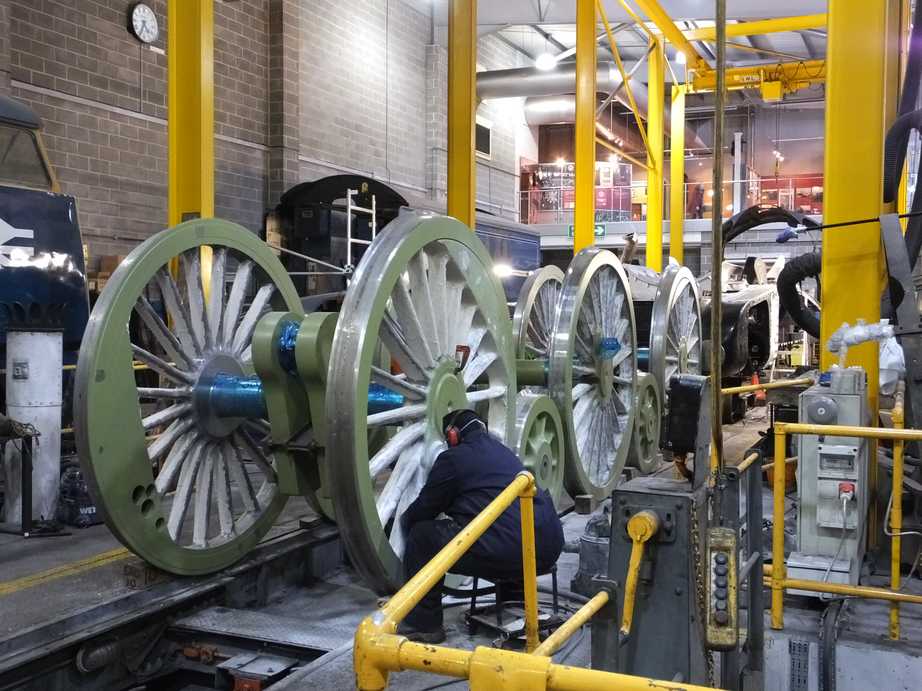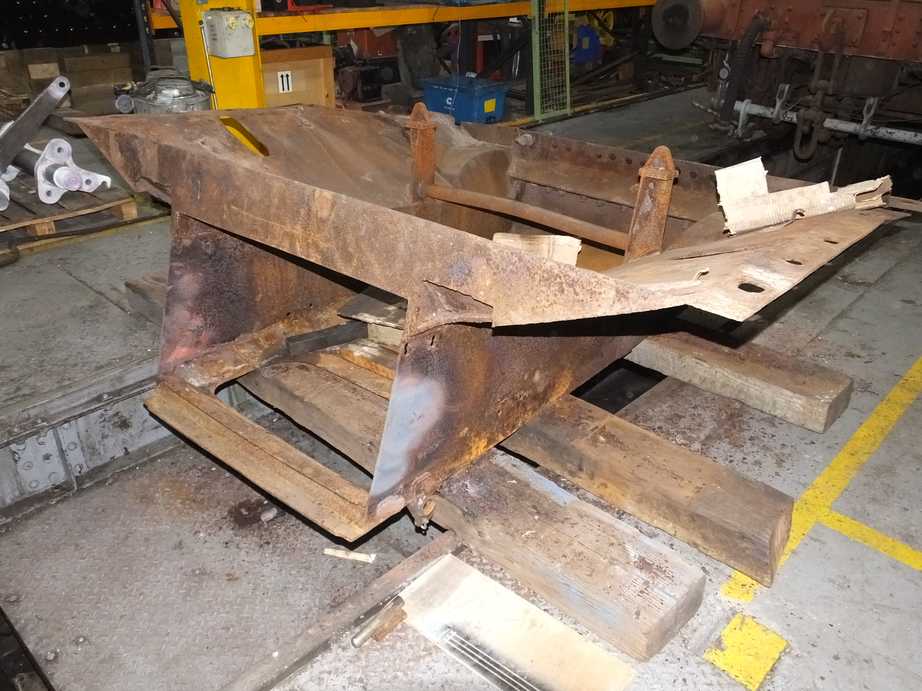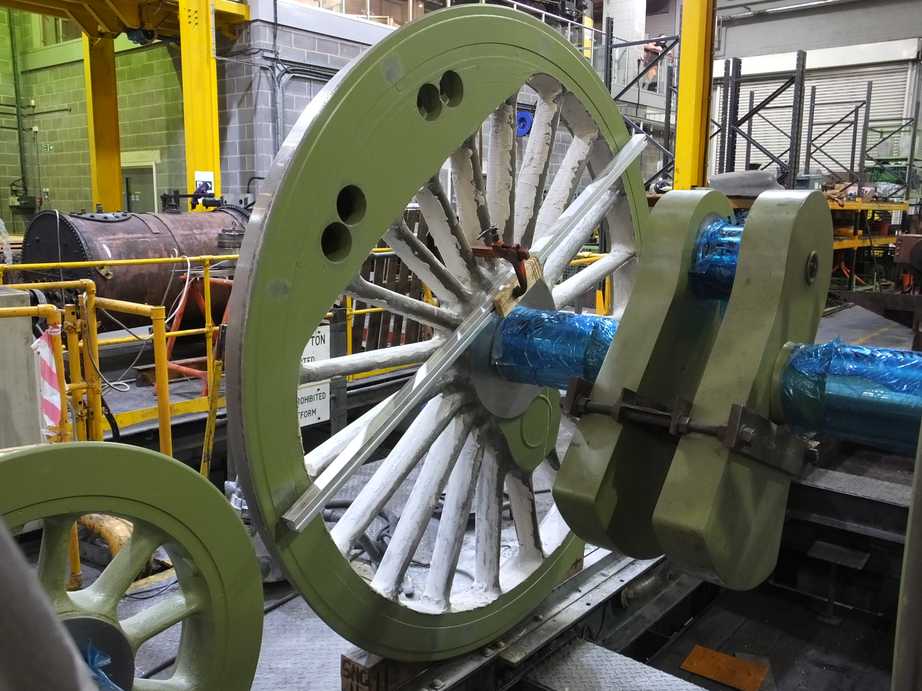Locomotive Engineer Darrin Crone provides us with an insight into recent weeks’ work on the restoration of the great locomotive.
Week commencing 30 October 2017
The air brake system continues to be worked on and the smaller control pipework is being fitted. Some joints were not in good condition so these have been dressed and a number of pipes are now in position. These pipes also run to the DV2 valve which controls the vacuum and air braking systems’ proportionality. The DV2 from the last period in service was dismantled and examined to determine which version we have. This has now been established and a refurbished valve of the correct type has been sent to us from contractor overhaul. We expect delivery of the valve in the next few days.
The vacuum pipe systems have been worked on this week, with further refurbishment of the pipe flanges. The pipes being worked on have been painted in primer and the inside of the pipes blown through or scraped to remove grime and rust.
No further work was done on the brake cylinders this week, but we did receive the new neck seal for the 24″ vacuum cylinder. We have now been told by spare parts suppliers that the neck bush for this type of cylinder is not available, so we will have to make one.
A considerable amount of time has been spent applying filler to the coupled wheels. The spokes are being sanded at the moment, but there is still lots to do at the end of the spokes and the inside of the wheel edges.

All the coupled wheels have now seen filler and many have been finish sanded, but there’s a long way to go yet.
Reaming of the bogie horn stay bolt holes was completed this week. The last new fitted bolts were machined and finally fitted. Once the horn stays were removed for final fitting, they were dye penetrant inspected around the bolt holes. No faults were found. In addition, more fitted bolts for the right leading combined spring and brake bracket were machined. By the end of the week only two still need to be machined and fitted.
The bogie springs were retrieved from store and are now in the works. The spare is being examined to ensure that it has the same dimensions as the springs used in traffic. The bogie rubber springs are life expired and I had hoped that they were standard coach examples, which are easy to obtain. We have talked to North Yorkshire Moors Railway’s Carriage and Wagon department, and unfortunately they confirmed they are not. However, this week a manufacturing drawing was located in the National Railway Museum library and we are now preparing our own drawings and will look for suppliers.
The tender sump was finish welded this week. The new plate had been previously fitted. The sump flange and the bolts were also welded in position. After welding our hot work team moved on to the repair of the ashpan. This involved heating the front of the ashpan to allow straightening the damper door opening. The front side ashpan plates need more attention to straighten out some bulging before it can be trial fitted in the frames.

The ashpan is now being repaired in the National Railway Museum workshop. The heated areas can be seen at the front of the ashpan where the plates are being straightened.
Painting continued this week with another coat of primer around the Cartazzi frames and the loco bogie stretcher. The bogie cladding plates also received another coat of the paint.
The two wasted driver’s footstep rivets were finally removed this week. They will be replaced when we organise our next batch of riveting.
The re-pinning of the gravity sands mechanism continued this week with the machining of new pins and dressing the linkage holes.
The clackbox castings that were recast (because the previous examples had porosity) have now been preliminary machined and pressure tested. The good news is that they have all now passed, so we can proceed to final machining, assembly and final testing.
The measurements for machining the bogie axleboxes have now been finalised and these dimensions will be sent to the NYMR. Meanwhile, measurements are being taken from the coupled wheels—partly so that we have records for our files, but also importantly to provide the relevant dimensions for the NYMR to machine the coupled axleboxes.

A straight edge is clamped across the rear of one of the driving wheels so that the distance from the centre thrust face to the tyre profile can be measured. This will give us the required thickness of the front face of the axlebox.
Our man in Llangollen reports that the last parts of the firebox tubeplate have now been removed and repairs to the combustion chamber plates beneath continue. A template of the new tubeplate has been tried in position and the fit is good.
Week commencing 6 November
The filling and sanding of the coupled wheels has taken up a lot of time this week, but we are getting there. The end is in sight as all wheels have now received filler and had some sanding. There are very few areas that have not been sanded, but we will have to move the ashpan to allow the wheels to be rolled so we can get to the undersides of the last spokes.
We don’t seem to have the spec for the bogie springs on a stand-alone component drawing. We require this to specify spare springs now that we are going to fit our only spare. It can also be used to check the spare. The description is on the bogie assembly drawings, but we’ve found that it’s wise to check on the referenced component drawings. This week another trip to the National Railway Museum library was made and a drawing of the later bogie spring was found. Drawings were also produced of the loco rubber springs and a number of manufacturers contacted for quotes.

The bogie rubber spring on top of the ‘box’ it normally sits in. These are on the bottom of the steel coil suspension springs.
Drawings for the piston valve heads have been produced and checked and the order for the machining will be placed soon. The supplier has been selected. The initial purchase orders for the blanks cast some years ago have been retrieved from file, so that we have traceability for the material.
The AWS bell and “sunflower” were retrieved from store this week and will be overhauled by an Engineering Team volunteer off site.
We visited the supplier that has the clackbox castings this week and we have now given them a spec of the remaining machining that we require. After that visit I went to Flavell’s to see the superheater. They have put a layer of weld over the thin areas identified with the thickness tester on our last visit, and I have requested another layer be added. The regulator cross shaft has been welded and straightened and will be ready for collection soon.
In the Llangollen boiler shop the last parts of the copper tubeplate are now being removed. These are in the top corners. The welds around them are being removed along with the patch screws. NDT examination around the safety valve pads has shown that we don’t have any defects in this area.
The post Sir Nigel Gresley overhaul – Update 22 appeared first on National Railway Museum blog.




